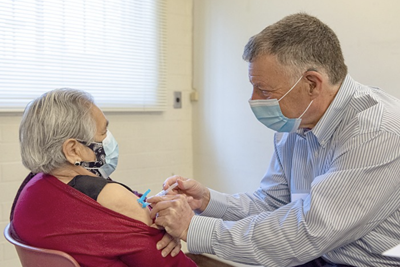(Photo credit: Santa Barbara News-Press)
The Santa Barbara News-Press covered Sansum Diabetes Research Institute’s COVID-19 vaccine distribution. To view the article click here, or read full article below.
A Sense of Security
by Madison Hirneisen
On Friday morning, Carpinteria resident Maria Cortez rolled up her sleeve to receive her second dose of the COVID-19 vaccine at the Sansum Diabetes Research Institute, making her one of the first 100 people to receive their second dose at that distribution site.
After a brief check-in, Ms. Cortez received her vaccine from Dr. Kenneth Waxman, a general surgeon and member of the SDRI Board of Trustees. The process from check-in to vaccination only takes about three minutes, but the effects are life-changing.
“I feel so happy and secure because of the second dose,” Ms. Cortez told the News-Press via a translator.
Obtaining the COVID-19 vaccine brings a sense of hope to Ms. Cortez and many others who belong to a demographic that is at high-risk for serious complications as a result of the virus. This demographic includes people over the age of 75 from the Hispanic and Latino communities with diabetes.
Beatriz Angeles, a community health worker assisting with the vaccine distribution at SDRI, said when people leave the clinic after receiving their vaccine, they are filled with gratitude and hope for the future.
“They feel like they won the lottery,” Ms. Angeles said.
The COVID-19 pandemic has had a disproportionate effect on minority communities in the U.S., including the population of Hispanic and Latino individuals living in Santa Barbara County. Rates of diabetes are doubled among Hispanic and Latino individuals compared to the background population, and this underlying condition puts them at risk for serious consequences of the virus.
“The Hispanic population, which is obviously a big part of our (county’s) demographic, has a higher instance of diabetes and they tend not to have access to health care, so the diabetes is not well controlled,” Dr. Waxman told the News-Press. “That combination puts them at very high risk of getting COVID, but also a much higher risk for hospitalization and death if they do contract the virus.”
Knowing the high-risk the virus poses to the elderly and diabetic within the Hispanic and Latino community, the SDRI has prioritized vaccinating this population locally. On Friday, the clinic at SDRI vaccinated about 50 people with the second dose of the Moderna vaccine and plans to vaccinate another group of 50 on Monday.
For SDRI, finding out when additional vaccine shipments are coming has been a waiting game.
But staff received the news Friday morning that 400 more first doses of the vaccine would be coming their way in a few weeks, giving them the opportunity to expand their vaccination progress to hundreds of elderly, diabetic Hispanic and Latino individuals still waiting.
According to Dr. David Kerr, Director of Research and Innovation at SDRI, 70% of the vaccines will be allocated to Hispanics and Latinos over the age of 65 with diabetes, and the other 30% will be allocated to essential workers.
“The vaccine is becoming a little bit more available in our community, but it’s a little bit of a game to get it,” Dr. Waxman said. “You have to be aggressive, you have to get in line, you have to be able to use the Internet, and this is a population that may not be the quickest in line. So the people who need the most are sometimes the people to get it in a competitive environment. This is going to target those people and give them access when their turn comes.”
With the second installment of the Moderna vaccine, individuals have a 95% chance of never catching the coronavirus and nearly a 100% chance of surviving the virus without the need for hospitalization if they do contract it, according to Dr. Waxman.
Goleta resident Maria Figueroa also received her second dose of the vaccine Friday morning. The process was quick, and Ms. Figueroa felt “very good” after receiving her second dose.
“I feel safer,” Ms. Figueroa told the News-Press via a translator.
As SDRI awaits the next shipment of the vaccine, the institute will be following public health guidance in its vaccination process while prioritizing Hispanic and Latino populations with type 1 or type 2 diabetes. To keep this commitment, SDRI is administering a limited number of vaccines to high-risk Hispanic and Latino populations by appointment or invitation only. To check eligibility and get on a vaccine waitlist, call SDRI’s bilingual staff at 805-699-1519.

